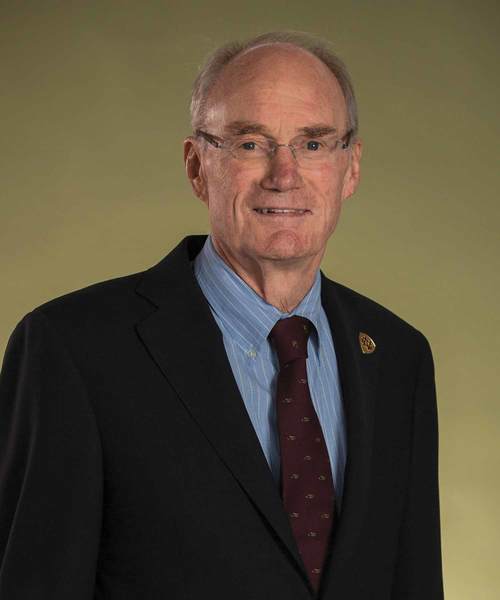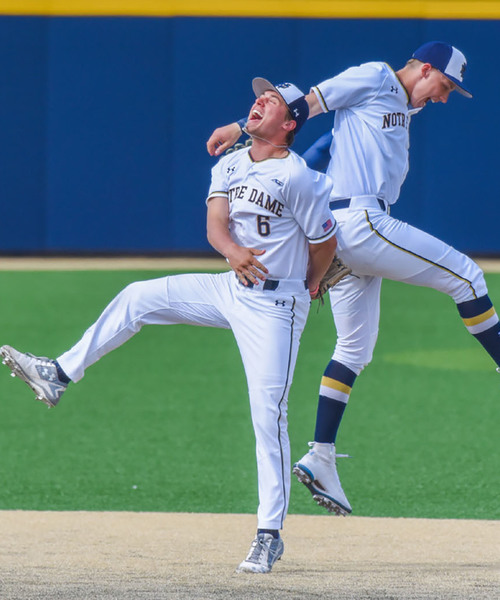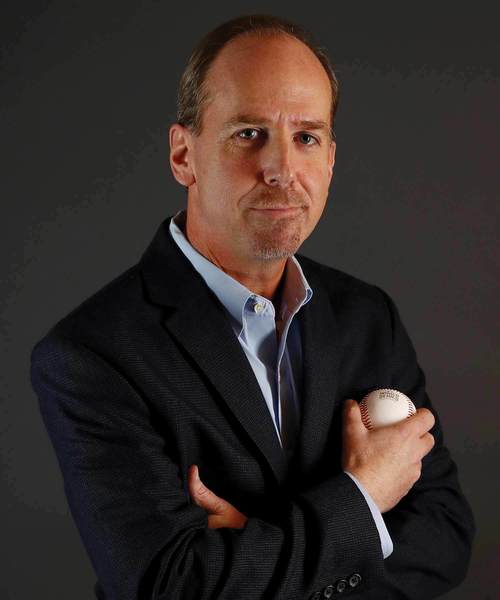
Joe Mendelson
Seeking that extra edge for the Irish
Switch-hitting sophomore Ryan Lidge dug his feet into the batter’s box and stroked a line drive. He glanced up and watched it land for a single in shallow center at Fenway Park under the Boston skyline … on a TV monitor in a batting cage at the University of Notre Dame.
Lidge and his fellow baseball players can instantly track and log every swing in the cage—including the velocity off the bat, distance, launch angle and projected outcome—on a high-tech video system called HitTrax.
“Especially since we’re a cold-weather team, this is like being outside at Fenway or Wrigley,” Lidge said. “Instead of guessing based on where the ball hits the (cage) net, this shows exactly where it went so you can follow it statistically instead of subjectively. The biggest thing for me is seeing the results while in the cage.”
The HitTrax system is both a teaching tool and a training motivator that could give a crucial edge to players at Notre Dame, the first university in the country to install the latest equipment used at some hitting academies. It’s just one example of the performance-improving technology provided for Notre Dame Olympic sports programs through the Joseph T. Mendelson Endowment for Athletics Excellence.
Joseph and Barbara Mendelson of Santa Barbara, California, established the fund in 2006 to provide incremental and non-budgeted money for Notre Dame’s Olympic sports (everything except football and basketball). Coaches can apply for funding to obtain technology or products that will help their athletes improve. The Mendelson Endowment has provided the Irish a vast array of aids, ranging from video golf simulators or new swimming platforms to extensive video analysis of games or GPS tracking of distances run in training.
Mendelson, an avid athlete and sports coach at many levels, said he came up with the idea while running barefoot on the beach.
“The purpose of the fund is to keep the Notre Dame sports teams up to date,” Mendelson said. “We’re in an age of technology and this is how you keep up.”
Born in Detroit, Mendelson’s love for Notre Dame took root early. He remembers taking the train to South Bend with his father, Herbert, who served on the University’s first Business Advisory Council during the presidency of Rev. John J. Cavanaugh, C.S.C.
“I was a kid and the place is kind of ground into you,” Mendelson said. His father built hydroplanes in the 1930s and ’40s, naming a boat he raced competitively the “Notre Dame.”
The Mendelson family moved to California after his mother died in 1947. His father passed away four years later when he was 14.
“As a kid in the 1940s, we didn’t have organized sports,” Mendelson said. “My mother was sick for seven years, and sports was my way of getting out of the house. It became a refuge and a motivator. Now it’s a way to keep healthy.”
Mendelson said he has always loved sports and has played or coached nearly all of them. His first coaching job came in the eighth grade at St. Paul the Apostle School where he took over the football team on which he played. He learned plays by going to UCLA practices and copying the single-wing offense run by legendary Bruin coach Red Sanders.
Over the years, Mendelson coached at high schools and colleges in California, and he helped start a cross country program at nearby Holy Cross College in South Bend. He also voluntarily assisted Joe Piane, who recently retired after 39 years at the helm of Notre Dame’s cross country and track teams, at Irish home meets.
Mendelson, who manages personal investments, has maintained his deep ties to Notre Dame. He was a charter member of the advisory council for the Institute for Church Life, serving as chair from 1980–86, and served on the advisory council of the Snite Museum of Art from 1986–89 and 1991–2000. His earlier generosity funded the Knute Rockne bronze sculpture at Notre Dame Stadium’s front gate.
Through his coaching travels, Mendelson said he could see that—aside from football and basketball—Notre Dame wasn’t as up to date as some other top athletic schools in its equipment. He suggested the idea of a fund to purchase the latest technology outside of the normal budget process.
An endowment committee was established, meeting twice a year to consider requests from coaches of all the Olympic sports. Mendelson also speaks to the coaches about their needs and makes suggestions about new equipment available. The committee is co-chaired by Jim Fraleigh, deputy athletics director at Notre Dame, and Bill Reagan, assistant director for athletics advancement. It also includes senior deputy athletic director Missy Conboy, senior associate athletics director Tom Nevala and Rev. Peter Jarret, C.S.C.
“Joe has always said he wanted the fund to touch as many student-athletes as possible,” Fraleigh said. “He’s now helped every program. Joe is all about competitive edge. The difference between a good team and a championship team can be so slight. So how can we provide that extra edge?”
Every sport has unique needs, but recent video technology seems to provide a wide-angle opportunity for performance enhancement. Former Irish football coach Lou Holtz once said, “If you can’t film it, it’s not worth doing.” That’s how much value coaches place on film.
Christine Halfpenny, the Irish women’s lacrosse coach, said there are so many more film resources in the market now than when she started coaching about a dozen years ago. Film sessions used to be one long game tape and you had to constantly rewind or fast forward trying to find the play you wanted to see, she said.
Her program recently used the Mendelson fund to contract with SportsCode Film to break down film of games and practices, compile video packages of formations or individual players to review habits in different situations and produce feature videos for use in the recruiting process.
Assistant coaches tag the plays, and the program breaks them down into short clips that can be grouped in different ways.
Sitting in her Joyce Center office, Halfpenny punched up attack plays from a recent game. She instantly streamed them onto a large television screen mounted on her wall to show how she can review clips with the players involved. She also can isolate a packet of plays featuring a single player, identify strengths and weaknesses and send the package to the player with voiceover comments. She can access everything on her iPad while traveling or recruiting. The players can log into the system on their own and watch different clips on their computer, pad or mobile phone.
“It’s really time-saving for us and it engages the players,” Halfpenny said of the film clips. “As in life, technology in sports has gone light speed, and everything we’re doing in AV has come through the Mendelson Fund.”
Besides SportsCode, her program bought new cameras and a tripod to film practices, something she was never able to do in previous jobs at other colleges. The goalies also use a shatterproof GoPro camera attached to their helmets to provide their view of oncoming shots. They even used the camera to film a recent ropes course team-building exercise, clips that went into their year-end video that is a prime recruiting tool. Halfpenny said the resources at Notre Dame are part of what sold her when she left William & Mary for the Irish in 2011.
Baseball coach Mik Aoki said Mendelson resources allowed his program to put six fixed cameras into Frank Eck Stadium. The cameras capture the best angle on every pitch, swing and fielding play during practices and games. The fund also bought better pitching machines.
Examples of state-of-the-art equipment through the Mendelson Endowment benefit every Olympic sport at Notre Dame. The swimming team received starting blocks with fins that accommodate a track-style start and also connect to the timing system to improve accuracy. The track teams have anti-gravity treadmills that can cost up to $80,000. Soccer teams purchased GPS units that monitor and track stresses on the body and distances run in both training and games. This allows the coaches to gauge player fitness and plan practices to prevent over-training so the players can peak during games.
Maybe the most immersive piece of new technology is a simulator the men’s and women’s golf teams use. The TruGolf simulator gives the option of playing about 80 courses from around the world. A turf hitting area allows the player to drive shots right into a huge picture of a course and watch the ball fly in video form on a 17-foot-by-10-foot screen. Different features such as wind speed can be controlled on the connected computer, and tracking software compiles 20 pieces of information on each swing, said Susan Holt, the Irish women’s golf coach.
“During the months of January and February, our kids can still feel like they’re playing golf,” Holt said. “They’ll have competitions. They will hit on the simulator up to the green, then putt on it or walk over to the indoor green to finish out. It’s fun to play and the constant and instant feedback on swing analysis is so beneficial.”
Mendelson is still amazed at all the new opportunities. He said equipment like the golf simulator can be the difference in recruiting the next great student-athlete to come to Notre Dame.
“Can you imagine,” he said, “if we had all that growing up?”
Thanks to the Mendelson Endowment, Notre Dame athletes can live out that dream.

